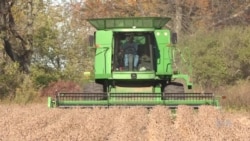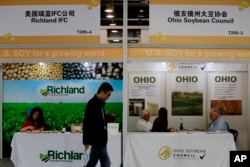It’s a good day for Illinois farmer Bob Gehrke, as the sun shines above the brown, dried and ready-for-harvest rows of soybeans in his fields outside Elgin.
A good day because Gehrke isn’t fighting wet weather as he spends up to 16 hours a day racing the clock and the calendar to harvest corn and soybeans.
“My biggest concern right now as we’re harvesting is not getting stuck,” he told VOA, “and that we get the crops out before Mother Nature throws snow at us.”
WATCH: US-China tariffs
The S-word isn’t his only concern this year. Farmers in the American Midwest are working the fields this fall amid a trade dispute between the United States and China, once one of the largest importers of U.S. corn and soybeans.
“The marketers' advice even this spring never was calling for soybeans to go down this extreme. Of course, they weren’t expecting a tariff,” Gehrke said.
Chinese tariffs on U.S. grain products, a retaliatory move for U.S. tariffs on Chinese steel and aluminum, have pushed soybean prices down as much as $2 this year.
“That’s a big deal for a farmer who is counting on that yield and that farm income,” said Tamara Nelsen, senior director of commodities for the Illinois Farm Bureau. “This is the fifth straight year of lower farm income, I think, the lowest farm income year since 2012 right now.”
Nelsen said news of a pending new trade agreement between the U.S., Mexico and Canada to replace the North American Free Trade Agreement, also known as NAFTA, so far isn’t doing much to put farmers at ease.
“Whether or not that was achieved because of the tariff threats remains to be seen, because the steel and aluminum tariffs still remain on Mexico and Canada, and their retaliatory tariffs threatened against us still remain.”
Gehrke had hoped decades of negotiations and relationships in China would be paying off, reversing declining farm income by keeping one of the largest markets for U.S. soybeans open. So far this year, USDA tracking shows that China accounts for only 5 percent of U.S. soybean exports.
“We built trade up to where it was working,” said Gehrke. “Now, in a matter of six months, a lot of that has been really knocked down, maybe even devastated, to where will it come back? How long will it take to come back?”
What was supposed to be a silver lining in an otherwise gloomy year for farmers was the U.S. Department of Agriculture’s estimated $12 billion aid package. While it helps offset his lower soybean prices — “they are saying we would get $1.60, $1.65 a bushel” — Gehrke said it doesn’t help his corn.
“It’s a penny,” he explained. “Why even bother if you are going to give us a penny? That’s more paperwork than it's worth. And then in their package, what they present — $200 million is for market development. We had the market! That’s sort of a joke.”
Soybeans are still being sold around the world, even if they might not be going to China. Sales to Europe and Argentina are up this year. So, the question remains: Are the trade tactics adopted by President Donald Trump and his administration ultimately working?
“I think if you ask most farmers right now, they would probably say no,” Gehrke told VOA during a rare working break. “But you ask them maybe a year from now, six months from now, they might change their mind.”
Six months from now, Gehrke himself will be in a very different mindset, shifting gears from harvesting his crops to planting seeds for a new growing season — a season he hopes is filled with more certainty.










